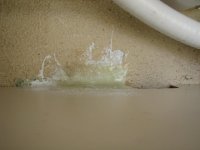Doryman
New member
- Joined
- Oct 3, 2006
- Messages
- 3,807
- Reaction score
- 0
- C Dory Year
- 2006
- C Dory Model
- 255 Tomcat
- Vessel Name
- Lori Ann
thataway":xs68j4br said:I see the ferrous brackets into the hull of the CD 25 as a problem, and all of these have been removed in mine (DIY--simple to do with glass tabbing the way it should have been done at first).
In the Tom Cat, there are no brackets screwed into the hull, they are screwed into a cored floor. This does not produce the risk which screwing into the hull gives, since there should be no water standing on the floor or water intrusion into the core of the floor. But it would be best to remove these and do tabbing instead in the long run. It probably will quiet the boat some also.
I'm breaking this thread off from the "My oberservations after my first ride on a C-25 and Tomcat" discussion.
To me, the implication of using a tab means basically a right-angle "piece" of fiberglass through which a screw would be inserted.
Am I correct in understanding that, in this context, you are basically glassing the bulkhead or cabinet member to the hull?
Thanks,
Warren

